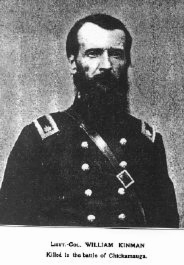
 |
||
 |
Lt. Colonel William Kinman 115th Illinois Volunteer Infantry |
 |
 |
||

|
||
|
Colonel Kinman was born at Fort Knox, near the present city of Vincennes, Ind., May 6, 1812. His parents, Levi and Susannah Kinman, among the earliest settlers of western Indiana, had made their home in the forest near the Wabash River, till driven into the fort by bands of hostile Indians who had gone on the war path in the hope of reward from the British. Soon after the close of the war Levi Kinman and family removed to western Illinois and made a new settlement in what is now Pike County. In that far wilderness, forty miles from the nearest "grist mill," surrounded by Indians, often hos- tile, and subjected to the hardest usage of frontier life, William Kinman spent his boyhood, his only opportunity for education being in the school of adversity. When twenty years old he received from Governor Reynolds of Illinois a commission as second lieutenant of the Illinois troops, for service in the Black Hawk War, and it is said served in the same command with Abraham Lincoln. After the great chief was captured, he returned home and attended school at Illinois College, Jacksonville, making part of his expenses by work for the college. He then returned to Pike County, and soon after that married Miss Ann Shin, the daughter of a pioneer Methodist preacher, and settled on a small farm near Grigsville, IL. In the Mormon War he again entered the service, being a first lieutenant in the second battalion Illinois Volunteers. In June 1847, he was commissioned a captain in Company K, 5th Illinois Volunteers, for service in the Mexican War, and marched with Col. Sterling Price from Independence, MO., over the plains to Mexico, participating in several engagements. At the close of the war he again returned to civil life and settled on a fine farm near Jacksonville, where he filled many important positions, being for several years president of the County Agricultural Society. In 1861 he served as a commissioner, under appointment of Governor Yates, for the distribution of arms to Illinois troops. In 1862 he took an active part in the work of recruiting men for the service especially in raising a Morgan County regiment, the 101st. Company I of the 115th was largely the result of his labor, though he declined to take an office in it, expecting a commission as a field officer, which was received on his election to the position of lieutenant-colonel of the 115th regiment. Colonel Kinman was for a time its drill master and military trainer. Having had experience in three wars, he was familiar with the duties of an officer and with what should be expected of a soldier; hence Colonel Moore was glad to avail himself of his services in all such matters. He participated in all the service of the regiment till the battle of Chickamauga, except during a few weeks' absence because of sickness. He commanded the regiment some time while at Nashville in the winter of 1862-63, and afterwards at Wartrace. To him much of the credit is due for the drill, discipline and efficiency of the regiment, which gave it such a glorious record at Chickamauga, Resaca, Nashville and other battles. Noted for his kindness of heart and affable disposition that made him always easily approached by the humblest soldier, he was strict in discipline and firm in the discharge of every duty. Colonel Kinman knew no fear and never hesitated to go wherever duty called. In the assault on Snodgrass Hill he rode forward with the regiment, cheering the men on in the charge. As he was thus riding from right to left of the regiment, when bullets were flying thick and fast, he fell mortally wounded and a moment later was instantly killed by a second bullet. Capt. James A. Rutherford says of his death: "It was in our second charge; I was keeping my men in line and seeing that all did their duty, and while thus busy I heard a rattling noise near me and looked to see its cause; I saw that Colonel Kinman had just fallen from his horse. I went to his assistance and asked if he was badly hurt, to which he replied, ‘yes, mortally wounded in left breast,’ and then said, ‘raise me up’ as I attempted to do so, before he had time to speak another word, a second shot struck him in the forehead and he straightened out dead." His son, Capt. C. L. Kinman, speaking of his death says, "He had just ridden along the line encouraging the men to stand firm. The last I saw of him alive, he passed into a cloud of smoke to the left of Company I. He had been dead an hour before I knew it. When I found his body it was near General Thomas' headquarters, to which place it had been carried by Perry L. Van Cleve of Company I, and Perry P. Tolle, Humphrey Muck and Charles Barker of Company D. I wrote his name and regiment on a piece of paper and pinned it on him. Being unable to do more for him, I returned to the regiment." And thus the body of our brave Lieutenant-Colonel was left on Snodgrass Hill. He was never afterward identified, and with- out doubt lies among the unknown that were removed to, the National Cemetery at Chattanooga. |
Submitted by: William L. Baran
For corrections or additions, please contact Special Project Coordinator:
Kimberly
Morgan
Last Edited: 15 Mar 2025